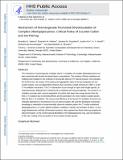Mechanism of Permanganate-Promoted Dihydroxylation of Complex Diketopiperazines: Critical Roles of Counter-cation and Ion-Pairing
Author(s)
Haines, Brandon E.; Nelson, Brandon M.; Grandner, Jessica M.; Kim, Justin; Houk, K. N.; Movassaghi, Mohammad; Musaev, Djamaladdin G.; ... Show more Show less
DownloadAccepted version (1.448Mb)
Terms of use
Metadata
Show full item recordAbstract
The mechanism of permanganate-mediated dual C-H oxidation of complex diketopiperazines has been examined with density functional theory computations. The products of these oxidations are enabling intermediates in the synthesis of structurally diverse ETP natural products. We evaluated, for the first time, the impact of ion-pairing and aggregation states of the permanganate ion and counter-cations, such as bis(pyridine)-silver(I) (Ag[superscript +]) and tetra-n-butylammonium (TBA[superscript +]), on the C-H oxidation mechanism. The C-H abstraction occurs through an open shell singlet species, as noted previously, followed by O-rebound and a competing OH-rebound pathway. The second C-H oxidation proceeds with a second equivalent of oxidant with lower free energy barriers than the first C-H oxidation due to directing effects and the generation of a more reactive oxidant species after the first C-H oxidation. The success and efficiency of the second C-H oxidation are found to be critically dependent on the presence of an ion-paired oxidant. We used the developed mechanistic knowledge to rationalize an experimentally observed oxidation pattern for C[superscript 3]-indole-substituted diketopiperazine (+)-5 under optimal oxidation conditions: namely, the formation of diol (-)-6 as a single diastereomer and lack of the ketone products. We proposed two factors that may impede the ketone formation: (i) the conformational flexibility of the diketopiperazine ring, and (ii) hindrance of this site, making it less accessible to the ion-paired oxidant species. Keywords: oxidation reactions; free energy; oxidation; quantum mechanics; transition metals
Date issued
2018-10-08Department
Massachusetts Institute of Technology. Department of ChemistryJournal
Journal of the American Chemical Society
Publisher
American Chemical Society (ACS)
Citation
Haines, Brandon E. et al. "Mechanism of Permanganate-Promoted Dihydroxylation of Complex Diketopiperazines: Critical Roles of Counter-cation and Ion-Pairing." Journal of the American Chemical Society 140, 41 (2018): 13375-13386 © 2018 American Chemical Society
Version: Author's final manuscript
ISSN
0002-7863
1520-5126